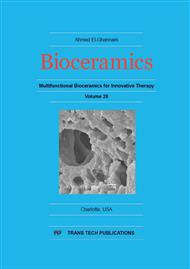[1]
Xia Y, Whitesides GM. Soft Lithography. Angew Chem Int Ed. 1998; 37: 550-75.
Google Scholar
[2]
Lee KB, Park SJ, Mirkin CA, Smith JC, Mrksich M. Protein nanoarrays generated by dip-pen nanolithography. Science. 2002 Mar 1; 295(5560): 1702-5.
DOI: 10.1126/science.1067172
Google Scholar
[3]
Wilson DL, Martin R, Hong S, Cronin-Golomb M, Mirkin CA, Kaplan DL. Surface organization and nanopatterning of collagen by dip-pen nanolithography. Proc Natl Acad Sci U S A. 2001 Nov 20; 98(24): 13660-4.
DOI: 10.1073/pnas.241323198
Google Scholar
[4]
Gilles S, Tuchscherer A, Lang H, Simon U. Dip-pen-based direct writing of conducting silver dots. J Colloid Interface Sci. 2013 Sep 15; 406: 256-62.
DOI: 10.1016/j.jcis.2013.05.047
Google Scholar
[5]
Arcos D, Vallet-Regi M. Sol-gel silica-based biomaterials and bone tissue regeneration. Acta Biomater. 2010 Aug; 6(8): 2874-88.
DOI: 10.1016/j.actbio.2010.02.012
Google Scholar
[6]
García C, Ceré S, Durán A. Bioactive coatings prepared by sol–gel on stainless steel 316L. J Non-Crystal Sol. 2004; 348: 218-24.
DOI: 10.1016/j.jnoncrysol.2004.08.172
Google Scholar
[7]
Singh LP, Bhattacharyya S, Ahalawat S, Kumar R, Mirshra G, Sharma U, et al. Sol-Gel processing of silica nanoparticles and their applications. Adv Colloid Interface Sci. 2014; 214: 17-37.
DOI: 10.1016/j.cis.2014.10.007
Google Scholar
[8]
Carvalho A, Pelaez-Vargas A, Gallego-Perez D, Grenho L, Fernandes MH, De Aza AH, et al. Micropatterned silica thin films with nanohydroxyapatite micro-aggregates for guided tissue regeneration. Dent Mater. 2012 Dec; 28(12): 1250-60.
DOI: 10.1016/j.dental.2012.09.002
Google Scholar
[9]
Pelaez-Vargas A, Gallego-Perez D, Carvalho A, Fernandes MH, Hansford DJ, Monteiro FJ. Effects of density of anisotropic microstamped silica thin films on guided bone tissue regeneration-in vitro study. J Biomed Mater Res B Appl Biomater. 2013 Jul; 101(5): 762-9.
DOI: 10.1002/jbm.b.32879
Google Scholar
[10]
Pelaez-Vargas A, Ferrel N, Fernandes MH, Hansford DJ, Monteiro FJ. Cellular Alignment Induction during Early In Vitro Culture Stages Using Micropatterned Glass Coatings Produced by Sol-Gel Process. Key Eng Mater. 2009; 396-398: 303-6.
DOI: 10.4028/www.scientific.net/kem.396-398.303
Google Scholar
[11]
Chung KK, Schumacher JF, Sampson EM, Burne RA, Antonelli PJ, Brennan AB. Impact of engineered surface microtopography on biofilm formation of Staphylococcus aureus. Biointerphases. 2007 Jun; 2(2): 89-94.
DOI: 10.1116/1.2751405
Google Scholar
[12]
Rahmany MB, Van Dyke M. Biomimetic approaches to modulate cellular adhesion in biomaterials: A review. Acta Biomater. 2013 Mar; 9(3): 5431-7.
DOI: 10.1016/j.actbio.2012.11.019
Google Scholar
[13]
Renner LD, Weibel DB. Physicochemical regulation of biofilm formation. MRS Bull. 2011 May; 36(5): 347-55.
DOI: 10.1557/mrs.2011.65
Google Scholar
[14]
Hochbaum AI, Aizenberg J. Bacteria pattern spontaneously on periodic nanostructure arrays. Nano Lett. 2010 Sep 8; 10(9): 3717-21.
DOI: 10.1021/nl102290k
Google Scholar
[15]
Horcas I, Fernandez R, Gomez-Rodriguez JM, Colchero J, Gomez-Herrero J, Baro AM. WSXM: A software for scanning probe microscopy and a tool for nanotechnology. Rev Sci Instrum. 2007; 78: 013705.
DOI: 10.1063/1.2432410
Google Scholar
[16]
Su M, Liu X, Li SY, Dravid VP, Mirkin CA. Moving beyond molecules: patterning solid-state features via dip-pen nanolithography with sol-based inks. J Am Chem Soc. 2002 Feb 27; 124(8): 1560-1.
DOI: 10.1021/ja012502y
Google Scholar
[17]
Kane RS, Takayama S, Ostuni E, Ingber DE, Whitesides GM. Patterning proteins and cells using soft lithography. Biomaterials. 1999; 20: 2363-76.
DOI: 10.1016/b978-008045154-1/50020-4
Google Scholar
[18]
Whitesides GM, Ostuni E, Takayama S, Jiang X, Ingber DE. Soft lithography in biology and biochemistry. Annu Rev Biomed Eng. 2001; 3: 335-73.
DOI: 10.1146/annurev.bioeng.3.1.335
Google Scholar


